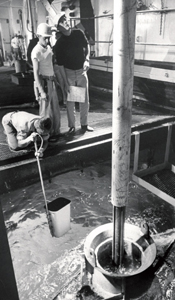Russians Dig to Reach Below Earth’s Crust
Read the full article (PDF) | Vote on future topic | Search archives
August 31, 1963 | Vol. 84 | No. 9
Russians Dig to Reach Below Earth’s Crust
THE RUSSIANS are digging through land to reach down just below the earth’s crust to the mantle and expect to dig from six to nine miles down within three to five years.
The digging is being done at five locations in the USSR, Prof. Vladimir V. Beloussov of the Soviet Academy of Sciences said in Berkeley, Calif. He is president of the International Union of Geodesy and Geophysics, which held a two-week meeting in Berkeley, Calif. Scientists from 60 nations attended.
The United States is planning to dig to the mantle through the ocean floor in a program called Project Mohole. Prof. Beloussov pointed out that since the two countries are approaching the exploration of the earth from two different angles, they are not competing with each other…
Prof. Beloussov noted that man now knows quite a bit about cosmic space, but that his knowledge of the earth reaches only a few miles into the ground and much of this knowledge is based on shaky theories.
Nuclear explosions for exploring the earth’s crust are not recommended by the Soviet seismologist. The upper mantle has a different composition and construction than the crust itself,Prof. Beloussov noted.
UPDATE | August 13, 2011
By land or by sea in the earth sciences’ ‘space race’
 During the first and only completed phase of the U.S. Project Mohole, scientists drilled more than 180 meters beneath the Pacific Ocean’s floor.
During the first and only completed phase of the U.S. Project Mohole, scientists drilled more than 180 meters beneath the Pacific Ocean’s floor.
While many had their sights on space in the 1960s, earth scientists were looking inward to the Moho — the Mohorovicic discontinuity, that is. Reaching the boundary between the Earth’s crust and mantle, named for Croatian seismologist Andrija Mohorovicic, would allow scientists to peer directly into the Earth’s innards, providing new insight into the planet’s makeup and history and informing controversial ideas about continental drift.
In 1961 Americans began drilling a series of experimental holes through the seafloor off the coast of Guadalupe, Mexico. The Russians countered: They’d dig deep as well, but rather than go through the seafloor, they’d go straight through dry land. Though scientists tried to emphasize that the two countries were not in competition, the tone at the time was clear: Collecting mantle rock was akin to bringing home bits of the moon.
One of the experimental holes dug by the Americans reached more than 180 meters below the seafloor, but plans to dig a larger Pacific hole down to the discontinuity, perhaps six kilometers or more, were called off in 1966 because of increasing costs. The Russians, who didn’t begin drilling until 1970, had reached a depth of more than 12 kilometers at a site on the Kola Peninsula by 1989, creating the record-setting Kola Superdeep Borehole. The 14- to 15-kilometer target depth was never achieved.
Today, half a century after the fi rst attempts to reach it, the boundary remains elusive. In Nature in March, two researchers described renewed interest in a Mohole campaign, driven largely by the Integrated Ocean Drilling Program and the Deep Carbon Observatory. — Elizabeth Quill
Credit: FRITZ GORO/TIME LIFE PICTURES/GETTY IMAGES